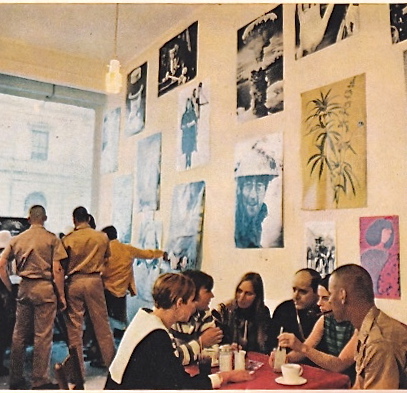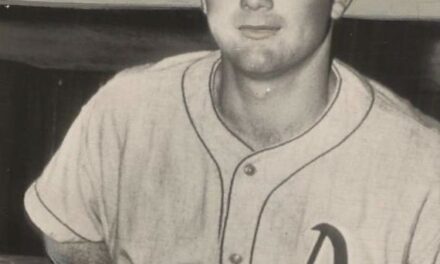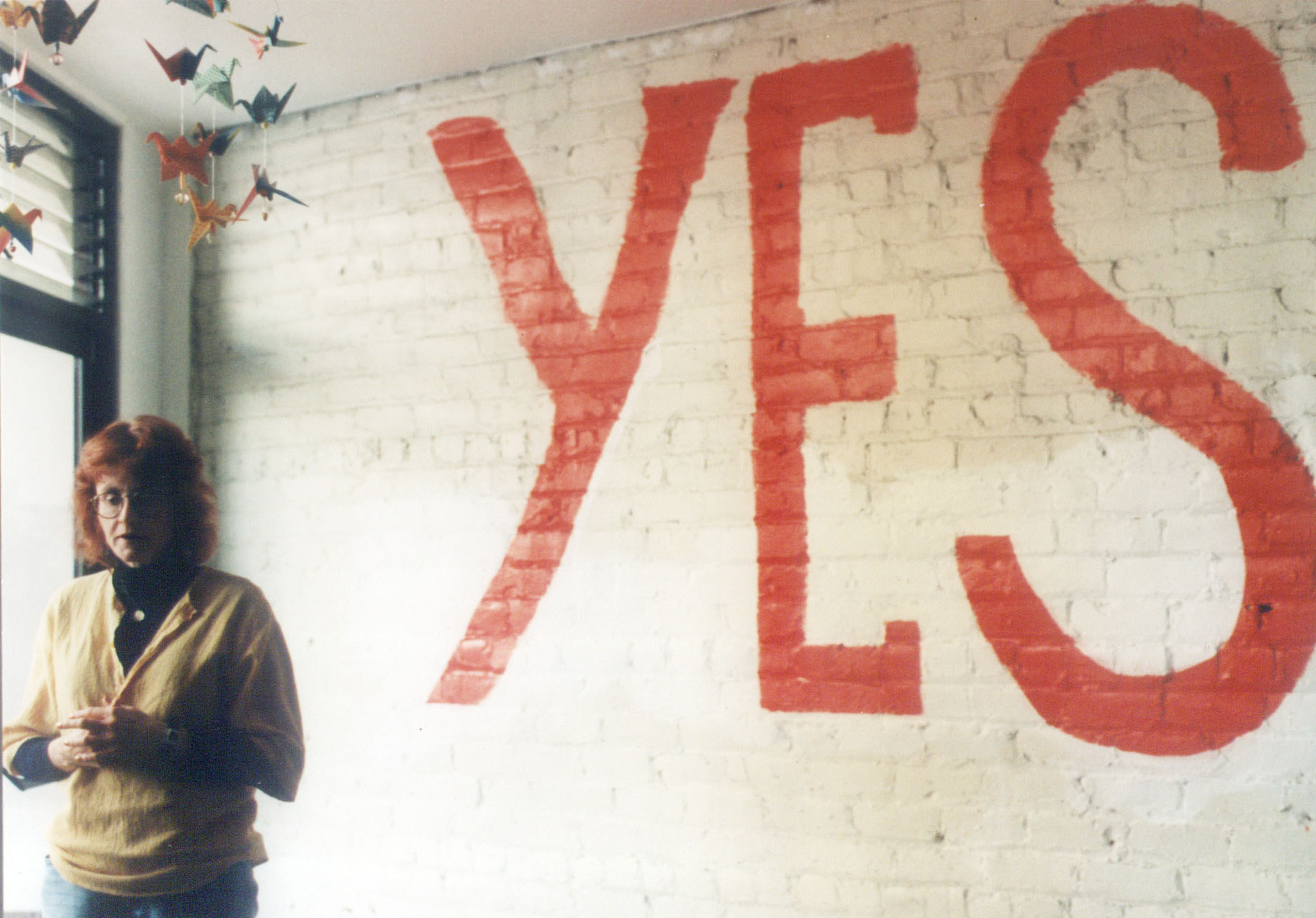By Fred Gardner Back in the 1960s and early ’70s, there was a big overlap between the people who wanted the freedom to smoke marijuana and the people who wanted US troops out of Vietnam —including many US troops. The issues intertwined, along with civil rights, women’s rights, gay rights. Everyone who smoked marijuana knew firsthand that the US government was lying about its harmfulness. This knowledge made millions of people suspicious that the government was lying about Vietnam, too. So the popularity of marijuana contributed to the demand for peace.
But at the same time, marijuana prohibition gave the government a potent weapon to wield against the peace movement. The following account of anti-war organizing in Killeen, Texas (near Fort Hood) is from Dangerous Grounds by David Parsons. The cover photo shows the UFO Coffeehouse in Columbia, South Carolina (near Fort Jackson). 
The Killeen group decided on a name for the coffeehouse: “The Oleo Strut,” referring to the vertical shock absorber on the underside of a helicopter. The Strut, as it came to be known, hoped to absorb the shock of service in the Vietnam era American military. The name was particularly appropriate for an establishment near Fort Hood, where 65% of the base’s 40,000 soldiers were recent returnees from service in Vietnam. Often referred to as “short-timers,” these veterans had completed their required 13-month tours in Vietnam, but still had months left in their overall service requirement, and spent their remaining time hanging around American bases with little to keep them occupied. As the Army itself soon recognized, short-timers were the soldiers most likely to engage in political activism against the war, and the staff of the Oleo Strut coffeehouse hoped to use these veteran’s war experiences and ample free time to stimulate a more vigorous antiwar discourse at Fort Hood.
The Oleo Strut coffeehouse’s grand opening celebration, held in Killeen’s Condor Park on July 5, 1968, captured the project’s unique balance of radical counterculture and radical politics. Strut organizers, along with activists from the University of Texas Veterans’ Committee (an Austin-based antiwar group), held a “love-in” that included folk and rock performances, antiwar speeches, and copious amounts of marijuana. Approximately eight hundred people attended the event, among them more than two hundred soldiers from Fort Hood. By the end of the day, Killeen police arrived in riot gear and broke up the party, but the Oleo Strut coffeehouse and its organizers had succeeded in making a highly visible entrance onto the town’s historically staid cultural scene…
That two hundred soldiers would show up to an event as clearly “hip” in orientation as a love-in was a testament to Fort Hood’s special status among soldiers of the era, many of whom were aware of the base’s notoriety for extensive drug use and insubordination. One reason for the base’s unusually high levels of marijuana use was a case of environmental serendipity: the intoxicating plant grew naturally in large amounts throughout the area. As one GI reported, “It grows wild all around the base, so when you go out on tank maneuvers you just reach out and grab all you want, dry it, and start smoking.” The base was so well-known among the military’s growing number of regular pot-smokers that in hip circles it earned the nickname “Fort Head.” The staff of the Oleo Strut coffeehouse recognized the counterculture developing among soldiers at Fort Hood, and initially hoped that the undirected anti-authority attitude it seemed to represent could be, at the coffeehouse, channeled into a more coherent challenge to the base’s leadership and the larger military establishment.
Countercultural events like the Strut-sponsored love-in may have attracted a large crowd of soldiers and young people, but a sizable group of Killeen residents were deeply offended by such public displays, and small bands of local vigilantes (often joined or supported by city police) regularly attacked the coffeehouse and its organizers in the early days of the Oleo Strut. These groups were mainly comprised of teenaged males, many of whom were Killeen high school students, who wreaked often alcohol-fueled havoc throughout town. The locals referred to them as “cowboys” or “goat-ropers.” Kicking off their campaign of terror against the Strut by smashing musical equipment at the love-in, the goat-ropers repeatedly broke the coffeehouse’s front windows, stole the Strut’s sign, and generally menaced the staff in the first weeks of the coffeehouse’s existence. The activists working at the Strut, informed by their personal political philosophies, initially took a nonviolent approach to the aggression, until local GIs convinced them to stock the store with baseball bats and a shotgun for self-defense. The goat-ropers only relented in their harassment after the staff threatened violent physical retaliation.
Political activity, organized by Fort Hood GIs, began developing at the Oleo Strut coffeehouse throughout the summer of 1968, despite the goat-ropers and other dangers. Private Bruce “Gypsy” Peterson began regularly leaving his post at Fort Hood to spend time at the coffeehouse, eventually founding and editing an underground antiwar newspaper for GIs, Fatigue Press, out of an office at the Strut. Fatigue Press formed a vital link between activists at the coffeehouse and soldiers at Fort Hood; Peterson, with the help of Strut staff, mimeographed hundreds of copies of the paper before smuggling them on base to covertly distribute them to fellow soldiers. Peterson’s work as an underground newspaper editor caught the attention of base leadership, and he soon discovered that his actions had provoked military and city authorities to wage their own campaign of repression against him.
In the first weeks of August 1968, just two months after the first hand-drawn issues of Fatigue Press had been brought on base, Peterson began to find small bags of marijuana planted in his base locker. He threw them away, disturbed by the sense that he was being set up. Over the course of the next month, Killeen city police arrested Peterson for marijuana possession three different times. The final arrest occurred as Peterson stood in front of the Oleo Strut coffeehouse, where police claimed to have found a microscopic amount of marijuana, mixed in with Peterson’s pocket lint. Despite the lab technician later admitting that the evidence was completely destroyed upon examination, Peterson was convicted in military court and sentenced to eight years of hard labor at Leavenworth federal penitentiary. The severe sentence failed in its intent to quell dissent at Fort Hood, however. Fatigue Press continued in Peterson’s absence (he was released on appeal two years later), delivering monthly antiwar movement news to Fort Hood GIs, edited and published by volunteer soldiers at the Oleo Strut coffeehouse.
Parsons tells the story of the “Fort Hood 43” —Black soldiers who refused riot-control duty in Chicago during the Democratic National Convention. It was the heaviest collective instance of GI dissent.
Black soldiers at Fort Hood were under a particular and immediate set of pressures that summer. Riots had erupted in black communities in more than 120 American cities in the wake of the twin assassinations of Martin Luther King, Jr. and Robert F. Kennedy in the spring. Thousands of American troops were dispatched to quell the violence throughout the year, with Fort Hood becoming the main training and deployment base for riot control duty. Black soldiers, many of whom had recently returned from Vietnam, were especially angry at having to re-deploy into the streets of their own neighborhoods, and increasing numbers began to resent their role in what the Army called “civil disturbance control.”
The resentment felt by many black soldiers at Fort Hood first peaked in late August 1968, as the base made preparations to send soldiers to Chicago during the Democratic Party’s national convention. After the violence of the Tet Offensive in Vietnam in January had laid waste to his constant claim of “victory around the corner,” Lyndon B. Johnson made the decision not to pursue another presidential term, throwing the party into disarray over the war issue. Chicago’s Mayor Richard Daley, imagining massive numbers of marauding antiwar protestors descending on the city, promised to keep order by any means necessary, and Illinois governor Samuel H. Shapiro promised his support in that effort. In addition to troops from the Illinois National Guard, soldiers from Fort Hood were to be mobilized and sent to Chicago for riot control duty.
In the days leading up to the convention, black soldiers at Fort Hood expressed opposition to these orders, and began to organize. A group of sixty black soldiers assembled at Fort Hood on the night of August 23, drew up a list of grievances and discussed, but did not decide on, whether they should refuse their orders to deploy to Chicago. Private Guy Smith, a Vietnam combat veteran, described the mood of the gathering: “A lot of black GIs knew what the thing [Chicago] was going to be about and they weren’t going to go and fight their own people.” The meeting went on through the night, to the consternation of base authorities, and when forty three men remained in the morning, all of them were arrested by military police.24 The Oleo Strut coffeehouse immediately leapt into action to support the arrested soldiers, helping mount the group’s defense and media strategy. In addition to providing a safe meeting space, the coffeehouse staff raised funds to hire a civilian lawyer, and publicized the group’s situation in Fatigue Press and as many other outlets as possible. The case of the Fort Hood 43, as it became known, was another instance in which Army authorities were caught off guard by the amount of publicity and sympathy given the defendants. While many of the soldiers involved still faced dishonorable discharges and (in some cases) prison time, the case was prominent in the mainstream press for over a year as the various courts-martial progressed. Moreover, the publicity brought further attention to the growing resentment toward riot control duty expressed by American soldiers and helped reveal the military’s significant internal problems with morale and insubordination.
For Josh Gould and the staff of the Oleo Strut, the lead-up to the highly-anticipated Chicago convention provided an opportunity to express solidarity with black soldiers who had resisted riot control deployment. A group of white soldiers who regularly visited the Strut, and who were among the 6,000 Fort Hood troops ordered to Chicago, had the idea to wear stickers on their helmets that would show that they were on the “side” of the demonstrators, despite their service in the military. The sticker itself, which depicted a white hand giving the peace sign, backed by a clenched black fist, employed the specific political iconography of the era while simultaneously hinting at some of the underlying tension and division within the antiwar movement. Gould himself planned to drive to Chicago to help distribute the stickers and spread word to antiwar demonstrators about their symbolic significance.
Circumstances ultimately prevented Gould’s intended activism at the 1968 convention. Three hours before his plane left for Chicago, Gould drove to the Oleo Strut for a final visit. On the way, he was pulled over by Killeen police for making an illegal right turn. The police searched his car and claimed to find “grains” of marijuana in the vehicle’s floor carpets, and arrested Gould. He was held in the Killeen city jail for eight days, through the duration of the convention in Chicago, until the police admitted that no marijuana was found in the car after all. Gould was released the day after the convention concluded, and assumed (though could not prove) that his arrest had been orchestrated to disrupt his political activities.
Parsons quotes a memo from FBI director J. Edgar Hoover reminding his agents that GI coffeehouse staff and patrons are likely to use marijuana —giving law enforcement grounds to bust them.
Federal authorities had their eye on the coffeehouse phenomenon from the moment it first appeared in Columbia, South Carolina, and took immediate action to disrupt its effectiveness. At the time, the FBI’s counterintelligence program (COINTELPRO) was operating around the country, under Director J. Edgar Hoover’s orders to “expose, disrupt, misdirect, discredit, or otherwise neutralize” subversive political organizations. In July 1968, the director issued a letter to all FBI field offices entitled “Disruption of the New Left,” that included specific plans for FBI agents to undermine the activities of antiwar groups. Hoover singled out the GI coffeehouse network as a target for special attention: “New Left groups are attempting to open coffeehouses near military bases in order to influence members of the Armed Forces. Wherever these coffeehouses are, friendly news media should be alerted to them and their purpose. In addition, various drugs, such as marijuana, will probably be utilized by individuals running the coffeehouses or frequenting them. Local law enforcement authorities should be promptly advised whenever you receive an indication that this is being done.” Federal agents thus became one part of a coordinated effort to harass antiwar activists at coffeehouse locations around the country.





